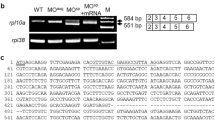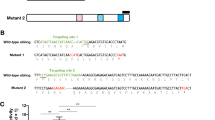Abstract
Peroxisomes are organelles that are essential for normal development in men and mice. In order to explore whether zebrafish could be used as a model system to study the role of peroxisomes, we examined their distribution pattern in developing and adult zebrafish and we tested different approaches to eliminate them during the first days after fertilization. In 4-day-old embryos, catalase-containing peroxisomes were obvious in the liver, the pronephric duct and the wall of the yolk sac, but transcripts for peroxisomal matrix and membrane proteins were also detected in the head region from 24 h post-fertilization. In adult zebrafish, catalase-containing peroxisomes remained prominent in the hepatocytes, the renal proximal tubules and the intestinal epithelium. Several peroxins, essential proteins for the biogenesis of peroxisomes, were targeted using knockdown approaches. Two morpholinos, blocking, respectively, splice sites in pex3 and pex13, only induced a short in frame deletion or insertion in the transcripts and did not result in the elimination of peroxisomes after injection into one-cell embryos. A morpholino blocking translation of pex13 was able to reduce the number of peroxisomes to variable extents. Finally, overexpression of a potential dominant negative fragment of Pex3p did not result in deletion of peroxisomes from developing zebrafish. We conclude that in zebrafish (1) peroxisomes, as visualized by DAB cytochemistry for catalase activity, are most conspicuous in the liver and renal tubular epithelium; this pattern is reminiscent of peroxisome occurrence in mammalian organs, (2) our approaches to eliminate these organelles during development by targeting peroxins were not successful.






Similar content being viewed by others
References
Baes M, Van Veldhoven PP (2006) Generalised and conditional inactivation of Pex genes in mice. Biochim Biophys Acta 1763:1785–1793
Braunbeck T, Görge G, Storch V, Nagel R (1990a) Hepatic steatosis in zebra fish (Brachydanio rerio) induced by long-term exposure to gamma-hexachlorocyclohexane. Ecotoxicol Environ Saf 19:355–374
Braunbeck T, Storch V, Bresch H (1990b) Species-specific reaction of liver ultrastructure in Zebrafish (Brachydanio rerio) and trout (Salmo gairdneri) after prolonged exposure to 4-chloroaniline. Arch Environ Contam Toxicol 19:405–418
Brocard C, Hartig A (2006) Peroxisome targeting signal 1: is it really a simple tripeptide? Biochim Biophys Acta 1763:1565–1573
Depreter M, Espeel M, Roels F (2003) Human peroxisomal disorders. Microsc Res Tech 61:203–223
Drummond IA (2005) Kidney development and disease in the zebrafish. J Am Soc Nephrol 16:299–304
Fahimi HD (1969) Cytochemical localization of peroxidatic activity of catalase in rat hepatic microbodies (peroxisomes). J Cell Biol 43:275–288
Field HA, Ober EA, Roeser T, Stainier DY (2003) Formation of the digestive system in zebrafish. I. Liver morphogenesis. Dev Biol 253:279–290
Fransen M, Wylin T, Brees C, Mannaerts GP, Van Veldhoven PP (2001) Human pex19p binds peroxisomal integral membrane proteins at regions distinct from their sorting sequences. Mol Cell Biol 21:4413–4424
Fujiki Y, Matsuzono Y, Matsuzaki T, Fransen M (2006) Import of peroxisomal membrane proteins: the interplay of Pex3p- and Pex19p-mediated interactions. Biochim Biophys Acta 1763:1639–1646
Gould SJ, Kalish JE, Morrell JC, Bjorkman J, Urquhart AJ, Crane DI (1996) Pex13p is an SH3 protein of the peroxisome membrane and a docking factor for the predominantly cytoplasmic PTS1 receptor. J Cell Biol 135:85–95
Grou CP, Carvalho AF, Pinto MP, Alencastre IS, Rodrigues TA, Freitas MO, Francisco T, Sá-Miranda C, Azevedo JE (2009) The peroxisomal protein import machinery—a case report of transient ubiquitination with a new flavor. Cell Mol Life Sci 66:254–262
Grunwald DJ, Eisen JS (2002) Headwaters of the zebrafish—emergence of a new model vertebrate. Nat Rev Genet 3:717–724
Ibabe A, Grabenbauer M, Baumgart E, Fahimi HD, Cajaraville MP (2002) Expression of peroxisome proliferator-activated receptors in zebrafish (Danio rerio). Histochem Cell Biol 118:231–239
Ibabe A, Bilbao E, Cajaraville MP (2005) Expression of peroxisome proliferator-activated receptors in zebrafish (Danio rerio) depending on gender and developmental stage. Histochem Cell Biol 123:75–87
Jones JM, Morrell JC, Gould SJ (2004) PEX19 is a predominantly cytosolic chaperone and import receptor for class 1 peroxisomal membrane proteins. J Cell Biol 164:57–67
Kammerer S, Holzinger A, Welsch U, Roscher AA (1998) Cloning and characterization of the gene encoding the human peroxisomal assembly protein Pex3p. FEBS Lett 429:53–60
Lazarow PB (2006) The import receptor Pex7p and the PTS2 targeting sequence. Biochim Biophys Acta 1763:1599–1604
Liu Y, Bjorkman J, Urquhart A, Wanders RJ, Crane DI, Gould SJ (1999) PEX13 is mutated in complementation group 13 of the peroxisome-biogenesis disorders. Am J Hum Genet 65:621–634
Lorent K, Yeo SY, Oda T, Chandrasekharappa S, Chitnis A, Matthews RP, Pack M (2004) Inhibition of jagged-mediated notch signaling disrupts zebrafish biliary development and generates multi-organ defects compatible with an Alagille syndrome phenocopy. Development 131:5753–5766
Maxwell M, Bjorkman J, Nguyen T, Sharp P, Finnie J, Paterson C, Tonks I, Paton BC, Kay GF, Crane DI (2003) Pex13 inactivation in the mouse disrupts peroxisome biogenesis and leads to a Zellweger syndrome phenotype. Mol Cell Biol 23:5947–5957
Meinecke M, Cizmowski C, Schliebs W, Krüger V, Beck S, Wagner R, Erdmann R (2010) The peroxisomal importomer constitutes a large and highly dynamic pore. Nat Cell Biol 12:273–277
Moulton JD (2007) Using morpholino to control gene expression. Curr Protoc Nucleic Acid Chem Chapter 4: Unit 4.30
Muntau AC, Mayerhofer PU, Paton BC, Kammerer S, Roscher AA (2000) Defective peroxisome membrane synthesis due to mutations in human PEX3 causes Zellweger syndrome, complementation group G. Am J Hum Genet 67:967–975
Nasevicius A, Ekker SC (2000) Effective targeted gene ‘knockdown’ in zebrafish. Nat Genet 26:216–220
Ng AN, de Jong-Curtain TA, Mawdsley DJ, White SJ, Shin J, Appel B, Dong PD, Stainier DY, Heath JK (2005) Formation of the digestive system in zebrafish: III. Intestinal epithelium morphogenesis. Dev Biol 286:114–135
Petriv OI, Pilgrim DB, Rachubinski RA, Titorenko VI (2002) RNA interference of peroxisome-related genes in C. elegans: a new model for human peroxisomal disorders. Physiol Genomics 10:79–91
Roels F, De Prest B, De Pestel G (1995) Liver and chorion cytochemistry. J Inherit Metab Dis 18(Suppl 1):155–171
Schrader M, Fahimi HD (2008) The peroxisome: still a mysterious organelle. Histochem Cell Biol 129:421–440
Shimozawa N, Suzuki Y, Zhang Z, Imamura A, Toyama R, Mukai S, Tsukamoto T, Osumi T, Orii T, Wanders RJA, Kondo N (1999) Nonsense and temperature-sensitive mutations in PEX13 are the cause of complementation group H of peroxisome biogenesis disorders. Hum Mol Genet 8:1077–1083
Soukupova M, Sprenger C, Gorgas K, Kunau W-H, Dodt G (1999) Identification and characterization of the human peroxin PEX3. Eur J Cell Biol 78:357–374
Stalmans I, Ng YS, Rohan R, Fruttiger M, Bouche A, Yuce A, Fujisawa H, Hermans B, Shani M, Jansen S, Hicklin D, Anderson DJ, Gardiner T, Hammes HP, Moons L, Dewerchin M, Collen D, Carmeliet P, D’Amore PA (2002) Arteriolar and venular patterning in retinas of mice selectively expressing VEGF isoforms. J Clin Invest 109:327–336
Steinberg SJ, Dodt G, Raymond GV, Braverman NE, Moser AB, Moser HW (2006) Peroxisome biogenesis disorders. Biochim Biophys Acta 1763:1733–1748
Thieringer H, Moellers B, Dodt G, Kunau WH, Driscoll M (2003) Modeling human peroxisome biogenesis disorders in the nematode Caenorhabditis elegans. J Cell Sci 116:1797–1804
Thisse B, Heyer V, Lux A, Alunni V, Degrave A, Seiliez I, Kirchner J, Parkhill JP, Thisse C (2004) Spatial and temporal expression of the zebrafish genome by large-scale in situ hybridization screening. Methods Cell Biol 77:505–519
Vize PD, Seufert DW, Carroll TJ, Wallingford JB (1997) Model systems for the study of kidney development: use of the pronephros in the analysis of organ induction and patterning. Dev Biol 188:189–204
Wallace KN, Akhter S, Smith EM, Lorent K, Pack M (2005) Intestinal growth and differentiation in zebrafish. Mech Dev 122:157–173
Wanders RJA, Waterham HR (2006) Biochemistry of mammalian peroxisomes revisited. Annu Rev Biochem 75:295–332
Yokota S, Togo SH, Maebuchi M, Bun-Ya M, Haraguchi CM, Kamiryo T (2002) Peroxisomes of the nematode Caenorhabditis elegans: distribution and morphological characteristics. Histochem Cell Biol 118:329–336
Acknowledgments
Prof. P. Carmeliet, A. Van den Eynde, S. Verstraeten and A. Claeys from the Vesalius Research Centre, Flanders Institute of Biotechnology and K.U.Leuven are acknowledged for sharing their expertise in zebrafish research and their facility for zebrafish maintenance and microinjections. We thank C. Brees, L. Pauwels, S. Louwette, D. Jacobus for excellent technical assistance. This work was supported by Fonds Wetenschappelijk Onderzoek Vlaanderen (G.0385.05), Geconcerteerde Onderzoeksacties (2004/08) and OT (08/040).
Author information
Authors and Affiliations
Corresponding author
Additional information
Olga Krysko and Mieke Stevens, and Marc Espeel and Myriam Baes contributed equally to this work.
Electronic supplementary material
Below is the link to the electronic supplementary material.
Rights and permissions
About this article
Cite this article
Krysko, O., Stevens, M., Langenberg, T. et al. Peroxisomes in zebrafish: distribution pattern and knockdown studies. Histochem Cell Biol 134, 39–51 (2010). https://doi.org/10.1007/s00418-010-0712-z
Accepted:
Published:
Issue Date:
DOI: https://doi.org/10.1007/s00418-010-0712-z




